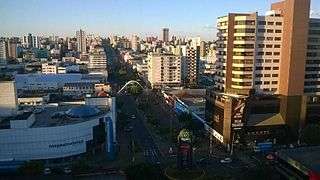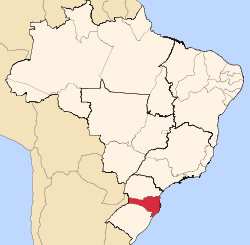Santa Catarina (state)
Santa Catarina (Brazilian Portuguese: [ˈsɐ̃tɐ kataˈɾinɐ] (![]()
State of Santa Catarina | |
|---|---|
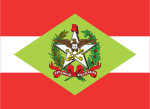 Flag 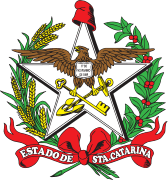 Coat of arms | |
| Anthem: Hino do Estado de Santa Catarina | |
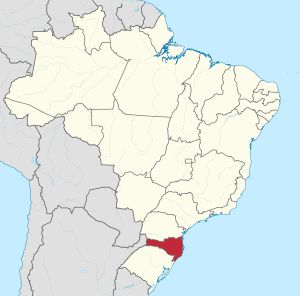 Location of State of Santa Catarina in Brazil | |
| Coordinates: 27°15′S 50°20′W | |
| Country | |
| Largest city | Joinville |
| Capital | Florianópolis |
| Government | |
| • Governor | Comandante Moisés (PSL) |
| • Vice Governor | Daniela Reiner (PSL) |
| • Senators | Dário Berger (MDB) Esperidião Amin (PP) Jorginho Mello (PR) |
| Area | |
| • Total | 95,346.181 km2 (36,813.366 sq mi) |
| Area rank | 20th |
| Population (2014)[1] | |
| • Total | 6,727,000 |
| • Rank | 11th |
| • Density | 71/km2 (180/sq mi) |
| • Density rank | 9th |
| Demonym(s) | Catarinense or Barriga-Verde (Green Belly) |
| GDP | |
| • Year | 2015 estimate |
| • Total | US$133 billion (PPP) US$75 billion (nominal) (6th) |
| • Per capita | US$19.084 (PPP) US$10.783 (nominal)(4th) |
| HDI | |
| • Year | 2017 |
| • Category | 0.808[2] - very high (3rd) |
| Time zone | UTC-3 (BRT) |
| Postal Code | 87000-000 to 89990-000 |
| ISO 3166 code | BR-SC |
| Website | sc.gov.br |
Santa Catarina is bordered by Paraná to the north, Rio Grande do Sul to the south, the Atlantic Ocean to the east, and to the west by the Argentine province of Misiones. The coastal path is over 450 km, i.e., about half of Portugal's mainland coast. The host city of the state executive, legislative and judiciary powers is the capital Florianópolis. Joinville, however, is the most populous city in the state. Besides Espírito Santo, Santa Catarina is the only state whose capital is not the most populous city.[6] South of the Tropic of Capricorn, situated in the planet's southern temperate zone, the state has a humid subtropical climate (Cfa) in the east and west and an oceanic climate (Cfb) in the center.[7] Climatic conditions vary according to the relief of the region: in the west and mountainous plateau, it is relatively frequent that frosts and snow occur, while on the coast the climate is warmer, being possible to reach high temperatures in summer.[7]
The territory of Santa Catarina was one of the oldest states in Brazil, separated from São Paulo in 1738, its first governor being José da Silva Pais. The state was created for one reason only: to extend the Portuguese domains to southern Brazil until reaching the Rio de la Plata region. It is also the oldest state of the South Region of Brazil, older than Rio Grande do Sul (1807) and Paraná (1853). The state of Santa Catarina was very settled by European immigrants: the coast was colonized by the Azorean Portuguese in the 18th century; the Itajaí Valley – a portion of the southern region and northern Santa Catarina – was settled by the Germans in the mid 19th century.[8][9] The south of the state was populated by the Italians in the last years of the 19th century. Children and grandchildren of Italian and German immigrants who moved from Rio Grande do Sul settled the west of Santa Catarina in the mid 20th century. Descendants of Africans and Indigenous also populated the state.[10]
The state's social indexes are among the best in Brazil. It has the highest rate of life expectancy in the country (just like the Federal District),[11] the lowest infant mortality rate and is also the state with the lowest economic inequality and illiteracy in Brazil.[12][13] Santa Catarina has the 6th highest GDP in the country,[14] with a diverse economy and strong affinities to industrialization. An important export and consumption hub, it is one of the fastest-growing states in the Brazilian economy and accounts for 4% of the country's gross domestic product.[15]
Geography
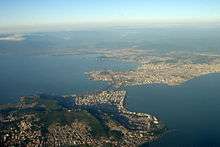
Santa Catarina is in a very strategic position in Mercosul, the South American Common Market. Its position in the map is situated between the parallel 25º57'41" and 29º23'55" of the Southern latitude and between the meridians 48º19'37" and 53º50'00" of Western longitude. Florianópolis, its capital, is 1,673 km (1,040 mi) from Brasilia, 705 km (438 mi) from São Paulo, 1,144 km (711 mi) from Rio de Janeiro and 1,850 km (1,150 mi) from Buenos Aires.
The Serra Geral, a southern extension of the Serra do Mar, runs north and south through the state parallel to the Atlantic coast, dividing the state between a narrow coastal plain and a larger plateau region to the west.
The Atlantic coast of Santa Catarina has many beaches, islands, bays, inlets, and lagoons. The humid tropical Serra do Mar coastal forests cover the narrow coastal zone, which is crossed by numerous short streams from the wooded slopes of the serras.[16]
The central part of the state is home to the Araucaria moist forests, dominated by emergent Brazilian pines (Araucaria angustifolia). The drainage of the plateau is westward to the Paraná River, the rivers being tributaries of the Iguaçu, which forms its northern boundary, and of the Uruguay River, which forms its southern boundary.[16] The semi-deciduous Paraná-Paraíba interior forests occupy the westernmost valleys of the Iguaçu and Uruguay rivers.
The highest point of the state is the Morro da Boa Vista, with an altitude of 1,827 m, and the second highest point is the Morro da Igreja, in the town of Urubici, with an altitude of 1,822 m.
History
- See also: History of Santa Catarina (state)
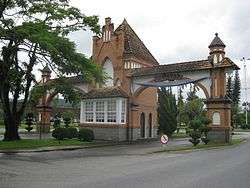
European settlement began with the Spanish settlement of Santa Catarina island in 1542. The Portuguese took control in 1675 and established the captaincy of Santa Catarina in 1738, bringing families from the Azores to populate the shore.
In 1839, during the Ragamuffin War, there was an unsuccessful attempt for Santa Catarina to secede from the Empire of Brazil to form the independent Juliana Republic (allied with the Riograndense Republic to the south) which was defeated after four months.
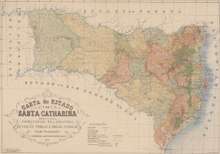
Between early 19th century and mid 20th century, a great number of European immigrants arrived to Santa Catarina; these immigrants were taken in order to populate the south of the Nation by Imperial initiative. About 50% of these immigrants were from Germany and Austria.[17] The rest came mainly from Italy, Poland, Russia, Ukraine, Netherlands, Norway, Sweden, Denmark, Luxembourg, Switzerland, Lithuania, France, Finland, Croatia, Serbia, Estonia, Slovenia and Latvia;[17] these immigrants created an abundance of small, family-held farms, many of which continue to exist in the interior of the state.
Late in March 2004, the state was hit by the first hurricane ever recorded in the South Atlantic. Because there is no naming system for such an event in Brazil, Brazilian meteorologists called it Hurricane Catarina, after the state.
Demographics
According to the IBGE of 2008, there were 6,091,000 people residing in the state. The population density was 61.53 inhabitants per square kilometre (159.4/sq mi).
Urbanization: 83% (2006); Population growth: 2% (1991–2000); Houses: 1,836,000 (2006).[18]
The last PNAD (National Research for Sample of Domiciles) census revealed the following numbers: 5,297,000 White people (86.96%), 608,000 Brown (Multiracial) people (9.98%), 160,000 Black people (2.63%), 15,000 Asian people (0.25%), 5,000 Amerindian people (0.09%).[19]
People of Portuguese ancestry, mostly Azoreans, predominate on the coast. People of German descent predominate in the northeast region (Itajaí Valley) and in the north (Joinville region). There are many German communities in the west. People of Italian descent predominate in the south, as well in many areas in the west. People of African, Amerindian or Japanese origin are present in small communities in a few towns.[20]
According to a genetic study with 20 samples (for 6.7 million people) from 2013, the population of Santa Catarina is made up by 79.7% European, 11.4% African and 8.9% Amerindian ancestry groups.[21] A genetic study found out an isolated Azorean-Brazilian community from Santa Catarina to have between 80.6% to 93.5% European input, along with 12.6% to 6.8% African and 4.1% to 2.4% Native American ancestries.[22][23]
European settlement
| Historical population | ||
|---|---|---|
| Year | Pop. | ±% p.a. |
| 1872 | 159,802 | — |
| 1890 | 283,769 | +3.24% |
| 1900 | 320,289 | +1.22% |
| 1920 | 668,743 | +3.75% |
| 1940 | 1,178,340 | +2.87% |
| 1950 | 1,560,502 | +2.85% |
| 1960 | 2,146,909 | +3.24% |
| 1970 | 2,930,411 | +3.16% |
| 1980 | 3,687,652 | +2.33% |
| 1991 | 4,538,248 | +1.90% |
| 2000 | 5,349,580 | +1.84% |
| 2010 | 6,248,436 | +1.57% |
| 2017 | 7,001,161 | +1.64% |
| source:[25] | ||
One of the Brazilian states that exhibits the most evident signs of 19th-century European immigration, Santa Catarina, where the vast majority of the population descends from European settlers, is also the state with the highest percentage of European phenotype citizens.
The state is also famous for having towns where most of the population belongs to a single main ancestry thanks to the settlement program with European colonists. Here are a few examples of such towns in the Southern region:
| Some southern Brazilian towns with a notable main ancestry | |||
|---|---|---|---|
| Town name | State | Main ancestry | Percentage |
| Nova Veneza | Santa Catarina | Italian | 95%[26] |
| Pomerode | Santa Catarina | German | 90%[27] |
| Treze Tílias | Santa Catarina | Austrian | 60%[28] |
Santa Catarina where over 50% of the population has German, Austrian and Luxembourgish ancestry[29][30][31] (the local Hunsrückisch is known as Katharinensisch,[32] East Pomeranian is still spoken in the town of Pomerode and Southern Austro-Bavarian by the Tyrolean population in Treze Tílias) was also the main destination for Danes in Brazil and the state that was sparsely populated and had its shore mainly inhabited by Azoreans in the 18th century (e.g. Laguna born Anita Garibaldi, wife and comrade-in-arms of Italian Unification revolutionary Giuseppe Garibaldi), also received Italians, French, Swedes, Norwegians, Swiss, Lithuanians and Latvians, Estonians, Finns, Poles, Slovenians, Croatians, Belgians, American Confederates and Spaniards to populate its interior during the 19th century. The town of Brusque founded by Austrian Baron von Schneeburg bringing German families from the Grand Duchy of Baden to settle in the northeast of Santa Catarina, besides receiving additional waves of Italians from the Tyrol–South Tyrol–Trentino Euroregion, Poles and Swedes, was also one of the destinations in the South and Southeast for American Confederate settlers in 1867, differing from São Paulo and Paraná colonies, where the American Confederate presence gave birth to new towns such as Americana in São Paulo. Neighboring towns such as Nova Trento founded in 1875, similarly received subjects from the Austro-Hungarian Empire due the fact that Italian-speaking Tyroleans known as trentinos and Germans from the Kingdom of Prussia, historic Swabia and Baden faced an immense crisis in the agricultural sector caused by the conflicts of the unification of Italy and Germany respectively, that weakened local trade. Istrian Italians under the Austrian Empire rule also fled Istria to settle in Brazil, and a few towns like Nova Veneza, founded in 1891 still have an over 90% Venetian population of which many still speak the Talian dialect. Most Venetians settled after the Third Italian War of Independence in 1866, when Venice, along with the rest of the Veneto, became part of the newly created Kingdom of Italy.[33][34][35][36][37][38][30][31][39][40]
Portuguese
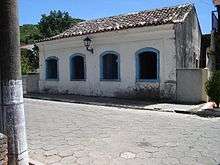
The Portuguese started arriving in the 1750s, mainly from the Azores islands, and colonized the coast. In the late 18th century, half of Santa Catarina's population was Portuguese-born. These Portuguese established many important towns in the state, such as Florianópolis, the capital.
Germans and Austrians
German people started arriving in 1828, after Brazilian independence. These were peasants attracted by the opportunity to have their own land, as Germanic countries were overpopulated and many people had no land to work. German immigration was very low until the 1850s, when waves started arriving in southern Brazil. To stimulate the German colonization of southern Brazil, the Brazilian government created many German colonies: these were ethnically Germanic areas where people from many parts of what is now Germany, Austria, Czech Republic and Poland settled. Initially, these colonies were in rural areas, where immigrants were able to cultivate their own farms. Many of these German colonies developed greatly and became large cities, Joinville and Blumenau a, among them.
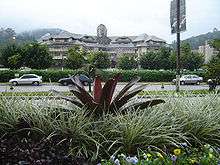
Germans were isolated in rural communities for decades. They did not have much contact with the other peoples of Brazil, and for generations they were able to speak the German language and maintain German traditions in Brazil. This situation changed in 1942, during World War II, when Brazil declared war on Germany, and German immigrants and their descendants were required to learn Portuguese and to culturally integrate their respective states.
Still, German influence in the state remains very strong and visible. Many towns and cities retain notable aspects of German culture: in Pomerode, for example, a small town in which nine-tenths of the population is of German-Brazilian descent, most inhabitants still speak German fluently; and Oktoberfest continues to be celebrated in Blumenau and in many other towns in the region. Architecture, too, shows German influence, as do popular customs and local cuisine.
People of German and Austrian descent made up the largest ethnic group among the population of Santa Catarina, at around 40% in 1950.[17]
Italians
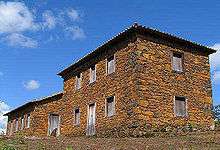
Italian settlers started arriving in Santa Catarina in 1875 and immigrated in large numbers until the 1910s. They were peasants from Northern Italy and established themselves in ethnically Italian colonies close to the coast. In the beginning, Italian settlements failed, because many Italians died of tropical diseases or left the colonies to find better conditions. However, in the Vale do Tubarão region (southern Santa Catarina), Italian immigrants found cooler weather and better lands, and the settlements prospered. Many Italians worked in the coal industry and, unlike the German immigrants, they did not dedicate themselves very much to agriculture. As they were not isolated in rural colonies, Italian immigrants were quickly integrated into the Brazilian population of Portuguese descent that had been living in Brazil since the 18th century.
Economy
The industrial sector is the largest component of GDP at 52.5%, followed by the service sector at 33.9%. Agriculture represents 13.6% of GDP (2004). Santa Catarina exports: aviculture 26.1%, wood products 15.4%, compressors 8.5%, cotton 6.8%, and vehicles 5.8% (2002).
Share of the Brazilian economy: 4% (2005).
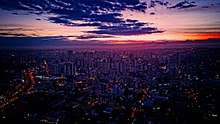
Santa Catarina has one of the highest standards of living in Brazil, and is a major industrial and agricultural center.
The capital city, Florianópolis, has a diversified economy, being an important pole for the technology industry and a major touristic destination. Commerce and services are also very strong in the capital. Cities from Florianópolis metro area, like São José, Palhoça and Biguaçu are important and diverse industrial poles, as well as strong commerce areas.
In the northeast of the state, electric-mechanical, textile and furniture industries are strong; in the west, cattle and poultry breeding predominate, while in the south it is ceramics and shellfish.
The corridor between Joinville, Jaraguá do Sul and Blumenau is heavily industrialized - more than 50% of the state's industrial output is concentrated in this small, but highly developed area.
The major cities and their respective fields are:
- Florianópolis, technology; tourism; services; commerce; government; education.
- Joinville, metal-mechanic; automobile; tourism/events; software development; commerce; plastic; textile; chemistry; education.
- Blumenau, textile; software; commerce and beer.
- São José, industry; commerce and services.
- Criciúma, ceramics.
- Chapecó, cattle and poultry breeding.
- Lages tourism and wood industry.
- Itajai, seaport.
- Jaraguá do Sul, electric motors and textile.
- Palhoça, industry.
- Balneário Camboriú tourism; commerce.
- Tubarão.ceramics
- Brusque, textile.
- Rio Negrinho, furniture.
- Caçador, furniture; metal-mechanics; agribusiness.
- Campos Novos, agribusiness.
- Concórdia, Swine industry.
- Curitibanos, Agribusiness, wood industry, education.
- São Joaquim, tourism.
See also agriculture in Santa Catarina.
Statistics
Vehicles: 2,489,343 (March/2007); Mobile phones: 3.7 million (April/2007); Telephones: 1.6 million (April/2007). Cities: 293 (2007).[41]
Education
Portuguese is the official national language, and thus the primary language taught in schools. English, Spanish and sometimes German are part of the official high school curriculum.
There are more than 105 universities within the state of Santa Catarina.[42]
Colleges and Universities

- Universidade Federal de Santa Catarina (UFSC) (Federal University of Santa Catarina) (Public);
- Universidade Federal da Fronteira Sul (UFFS) (Federal University of the Southern Border)(Public);
- Universidade do Estado de Santa Catarina (UDESC) (University of the State of Santa Catarina) (Public);
- Instituto Federal de Santa Catarina (IFSC) (Federal Institute of Santa Catarina) (Public);
- Instituto Federal Catarinense (IFC) (Santa Catarina's Federal Institute) (Public);
- Fundação Universidade Regional de Blumenau (FURB) (Regional University Foundation of Blumenau) (Public, but paid);
- Universidade do Sul de Santa Catarina (UNISUL) (University of Southern Santa Catarina) (Private);
- Universidade do Vale do Itajaí (UNIVALI) (University of the Itajaí Valley) (Private);
- Universidade da Região de Joinville (UNIVILLE) (University of the Region of Joinville) (Private);
- Universidade para o Desenvolvimento do Alto Vale do Itajaí (UNIDAVI) (University for the development of the upper valley of the Itajaí) (Private);
- Centro Universitário Leonardo da Vinci (UNIASSELVI) (University Center Leonardo da Vinci) (Private);
- Universidade Católica de Santa Catarina (Catholic University of Santa Catarina) (Private);
- Universidade do Contestado (UnC) (University of Contestado) (Private);
- Universidade do Oeste de Santa Catarina (Unoesc) (University of Western Santa Catarina) (Private);
- Universidade do Planalto de Santa Catarina (Uniplac) (University of the Plateau of Santa Catarina) (Private);
- Universidade do Extremo Sul Catarinense (Unesc) (University of Southernmost Santa Catarina) (Private);
- Sociedade Educacional de Santa Catarina (SOCIESC) (Educational Society for Santa Catarina)(Private);
Infrastructure
International Airport
Florianópolis is served by Hercílio Luz International Airport for both domestic and international flights. The traffic has grown significantly at the airport and therefore the city will shortly build a new airport able to serve 2.7 million passengers a year. The architectural design of the new airport was chosen by a public competition held by Infraero in partnership with the Brazilian Architects Institute (IAB). Among the over 150 original entries, the proposal of São Paulo architect Mário Bizelli was chosen. The construction work will be tendered in 2005 and should be finished in two years.
Tourism
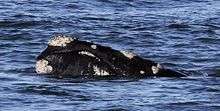
Santa Catarina offers a number of sights and events throughout the year: rural tourism, thermal mineral resorts, ecological tourism and adventure sports, historic monuments and sights, religious tourism, Beto Carrero World and Unipraias parks in Balneário Camboriú, and beach resorts of Florianópolis, Laguna, Porto Belo and Itajaí.
Some of these sights can only be seen in the off-season, like the snow on the Catarinense Mountain Range - one of the places in Brazil where it snows every year.
Between July and November, southern right whales visit the state's coast. And during the winter, flocks of penguins migrate from Antarctica.
The municipality of Timbó is a center for adventure sports like rafting and canyoning.
The great festivities take place in October. The main Oktoberfest of Blumenau is Brazil's largest and the world's second largest (after Germany's Munich).[43]
Joinville is the host city in July to the widely acclaimed "Joinville Dance Festival", the annual "Festival of Flowers" in November which showcases orchids produced in the region, and several business events in its Convention Center.
Florianópolis, the city/island State Capital attracts a large numbers of tourists during the summer months who visit its 42 beaches.
There are also many smaller resort towns, including the capital of the microlight aircraft tour flights Itapema, Piçarras, Barra Velha and Penha, home to the famous amusement park "Beto Carrero World".
An interesting collaboration between men and Nature that can be watched has been developed in Laguna (birthplace of Anita Garibaldi, the wife and comrade-in-arms of Italian Unification revolutionary Giuseppe Garibaldi): a pod of bottlenose dolphins drive fish towards fishermen who stand at the beach in shallow waters. Then one dolphin rolls over, which the fishermen take as sign to throw out their nets. The dolphins feed on the escaping fish. The dolphins were not trained for this behavior; the collaboration has been going on at least since 1847.[44][45] Southern right whales also can be seen in Laguna from shores during winter to spring seasons.[46]
The 17,491 hectares (43,220 acres) Turvo State Park, created in 1947, is in the northwest of the state.[47] It contains the Yucumã Falls (Portuguese: Salto do Yucumã, Spanish: Saltos del Moconá), a dramatic waterfall on the Uruguay River on the border with Argentina. Many tourists come to the park to see the falls, which are 1,800 metres (5,900 ft) long and up to 20 metres (66 ft) high.[48]
Sports
Football
The major football clubs of Santa Catarina are:
Criciuma EC from Criciúma. Criciúma EC, also known as "Tigre" (Tiger) has the most important championship won by a Santa Catarina Team in a very long time, being champion from the Copa do Brasil (Brazilian Cup) in 1991. Criciúma is the only team from Santa Catarina that played Libertadores of America Cup, in 1992, when it was 5th. Criciúma also won the Brazilian 2002 second series, and 2006 C series. Criciuma is currently playing Campeonato Brasileiro Série B, the Brazilian national second division.
Figueirense FC black and white from Florianopolis. Its nickname is Figueira (Fig tree) and it is also known as O Furacão do Estreito (The Hurricane of Estreito). Its stadium is the Orlando Scarpelli, located in the Estreito neighborhood, in the continental part of the city. Figueirense is currently playing in the Campeonato Brasileiro Série B, the second division of Brazilian football.
Avaí FC, blue and white from Florianopolis. It is also known as O Leão da Ilha (The Lion of the Island). Its stadium is the Aderbal Ramos da Silva, popularly known as Ressacada, located in the Carianos neighborhood, in the south part of the island. Avaí is currently playing in Campeonato Brasileiro Série B, the second division of Brazilian football.
Joinville Esporte Clube from Joinville. It is also known as "Tricolor" or "JEC". Joinville is currently playing in the Campeonato Brasileiro Série A, the first division of Brazilian football. JEC won the Campeonato Brasileiro Série B, the second division of Brazilian football, in 2014, but currently plays in Campeonato Brasileiro Série C, the third division of Brazilian football, after two consecutive relegations.
Associação Chapecoense de Futebol from Chapecó. Chapecoense is playing in the Campeonato Brasileiro Série A, the first and major division of Brazilian football. The club is currently recovering from the loss of virtually all of its first team in a 2016 plane crash.
Surfing
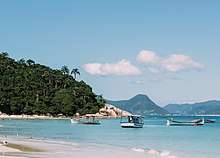
The Island, Island of Santa Catarina, is generally considered to have the best and most consistent waves in Brazil, and in April of each year hosts what is currently South America's only ASP (Association of Surfing Professionals) World Championship Tour professional surfing competition. Brazil has played host to many an ASP tour event over the past 30 years. Former contest sites include Rio de Janeiro, Barra de Tijuca and Saquarema, but the past four years have seen the tour set up shop in Florianopolis. Previously held towards the end of the tour, the past few years have seen several ASP world champions crowned in Brazil. In 2004 it was Andy Irons, and in 2005 it was Kelly Slater (who had his 2006 ASP World Title already stitched up by Brazil).
Tennis
Florianópolis is the hometown of Brazilian former tennis player Gustavo Kuerten.
Minority languages
The minority languages of the state of Santa Catarina can be divided into two distinct groups:
- Autoctone Languages or Indigenous Languages: Kaingang; Guaraní;
- Extoctone Languages or Immigration Languages: German (Hunsrückisch, Dutch, East Pomeranian, Plautdietsch, Austro-Bavarian, including more specifically Southern Austro-Bavarian); Italian (Talian or Venetian), Slavic (Polish, Ukrainian, Russian) and others, including Scandinavian (Norwegian, Swedish and Danish), Lithuanian, Yiddish, English and Japanese minorities.
In some cities and villages, German or Talian are still the main spoken language and enjoy co-official status.[49][50][51][52]
See also
- Comandante Moisés
- Hino do Estado de Santa Catarina
- List of cities in Brazil (all cities and municipalities)
Notes
- "Instituto Brasileiro de Geografia e Estatística". IBGE. 2012-08-31. Retrieved 2014-08-03.
- "Radar IDHM: evolução do IDHM e de seus índices componentes no período de 2012 a 2017" (PDF) (in Portuguese). PNUD Brasil. Retrieved 18 April 2019.
- Brazilian Official Territorial Area
- "2014 IBGE Estimates - Estimates of Resident Population in Brazil, Federative Units and Municipalities" (PDF) (in Portuguese). IBGE.gov.br. Retrieved 12 September 2014.
- (in Portuguese) Público. "Portugal tem 92.212 quilómetros quadrados, por enquanto...". Retrieved 2 July 2012. Archived 5 October 2012 at the Wayback Machine
- "IBGE | Cities | Santa Catarina | Joinville". cidades.ibge.gov.br. Retrieved 2019-08-09.
- Alvares, Clayton Alcarde; Stape, José Luiz; Sentelhas, Paulo Cesar; de Moraes Gonçalves, José Leonardo; Sparovek, Gerd (December 2013). "Köppen's climate classification map for Brazil". www.ingentaconnect.com. Retrieved 2019-08-09.
- CABRAL, Oswaldo R. História de Santa Catarina. Rio de Janeiro, RJ: Laudes, 1970.
- MATOS, Jacinto Antônio de. Colonização do Estado de Santa Catarina, Tip. de "O Dia": Florianópolis, 1917. 241 p.
- EL-KHATIB, Faissal. História de Santa Catarina. Curitiba, PR: Grafipar, 1970. 4 v.
- "Federation Units - Life expectancy at birth - Brazil - Total - 2017" (PDF). IBGE. p. 11. Retrieved November 29, 2018.
- "Complete mortality table for Brazil - 2015" (PDF). IBGE. Retrieved December 2, 2016.
- "Pesquisa Nacional por Amostra de Domicílios Contínua - PNAD Contínua | IBGE". www.ibge.gov.br. Retrieved 2019-08-09.
- Pontes, Helena Maria Mattos. "Contas Regionais 2015: queda no PIB atinge todas as unidades da federação pela primeira vez na série". IBGE - Agência de Notícias (in Portuguese). Retrieved 2019-08-09.
- Pontes, Helena Maria Mattos. "Contas Regionais 2016: entre as 27 unidades da federação, somente Roraima teve crescimento do PIB". IBGE - Agência de Notícias (in Portuguese). Retrieved 2019-08-09.
- Chisholm, Hugh, ed. (1911). . Encyclopædia Britannica. 24 (11th ed.). Cambridge University Press. p. 185.
- Ferreira Levy, Maria Stella. (in Portuguese) O Papel da Migração Internacional na Evolução da População Brasileira. pp. 58, 79
Santa Catarina, tem como grupo nacional mais importante os alemães cujas proporções oscilam ao redor de 40%, seguidos pelos italianos, com aproximadamente 17%, até o censo de 1950. Em 1970, a proporção de imigrantes italianos reduz-se a metade. As outras nacionalidades que tem expressão são poloneses, russos e austríacos com proporções entre 6 e 11%, considerando-se inclusive o censo de 1970.
— Page 58 - Source: PNAD.
- Pesquisa Nacional por Amostra de Domicílios (PDF) (in Portuguese). Santa Catarina, Brazil: IBGE. 2008. ISBN 978-85-240-3919-5. Retrieved 2010-01-18.
- Santa Catarina - Terra de Contrastes - Os Jeitos da Terra Archived December 12, 2007, at the Wayback Machine
- Saloum De Neves Manta, Fernanda; Pereira, Rui; Vianna, Romulo; Rodolfo Beuttenmüller De Araújo, Alfredo; Leite Góes Gitaí, Daniel; Aparecida Da Silva, Dayse; De Vargas Wolfgramm, Eldamária; Da Mota Pontes, Isabel; Ivan Aguiar, José; Ozório Moraes, Milton; Fagundes De Carvalho, Elizeu; Gusmão, Leonor (2013-09-20). "Revisiting the Genetic Ancestry of Brazilians Using Autosomal AIM-Indels". PLOS ONE. Plosone.org. 8 (9): e75145. doi:10.1371/journal.pone.0075145. PMC 3779230. PMID 24073242.
- "Archived copy" (PDF). Archived from the original (PDF) on 2014-09-03. Retrieved 2014-09-03.CS1 maint: archived copy as title (link)
- "Archived copy". Archived from the original on 2012-07-15. Retrieved 2014-08-23.CS1 maint: archived copy as title (link)
- "ESTIMATIVAS DA POPULAÇÃO RESIDENTE NOS MUNICÍPIOS BRASILEIROS COM DATA DE REFERÊNCIA EM 2018" (in Portuguese). Brazilian Institute of Geography and Statistics. 3 September 2018. Archived from the original (PDF) on 31 August 2011. Retrieved 3 September 2018.
- IGBE
- Nova Veneza Archived 2008-08-19 at the Wayback Machine
- POMERODE-SC
- História de Treze Tílias Archived 2008-11-02 at the Wayback Machine
- "Regiões de origem e de destino dos imigrantes teutônicos". ibge. Retrieved 2016-04-11.
- "Os imigrantes teutônicos no Brasil- alemães, austríacos, luxemburgueses, pomeranos e volga". ibge. Retrieved 2016-04-11.
- "Regiões de origem e de destino dos imigrantes teutônicos". ibge. Retrieved 2016-04-11.
- "Katharinensisch". universal_lexikon.deacademic. Retrieved November 8, 2016.
- "Províncias de origem dos imigrantes italianos". ibge. Retrieved 2016-04-11.
- Marília D. Klaumann Cánovas (2004). "A GRANDE IMIGRAÇÃO EUROPÉIA PARA O BRASIL E O IMIGRANTE ESPANHOL NO CENÁRIO DA CAFEICULTURA PAULISTA: ASPECTOS DE UMA (IN)VISIBILIDADE" [The great European immigration to Brazil and immigrants within the Spanish scenario of the Paulista coffee plantations: one of the issues (in) visibility] (PDF) (in Portuguese). cchla.ufpb.br. Archived from the original (PDF) on 3 October 2009.
- "Principais levas de imigração para o Brasil". Abril. Retrieved 6 April 2016.
- "Entrada de estrangeiros no Brasil". Retrieved 2014-01-23.
- "Regiões de destino dos imigrantes italianos". ibge. Retrieved 2016-04-11.
- Wojciech Tyciński, Krzysztof Sawicki, Departament Współpracy z Polonią MSZ (2009). "Raport o sytuacji Polonii i Polaków za granicą (The official report on the situation of Poles and Polonia abroad)" (PDF). Warsaw: Ministerstwo Spraw Zagranicznych (Ministry of Foreign Affairs of Poland). pp. 1–466. Archived from the original (PDF file, direct download 1.44 MB) on July 21, 2012. Retrieved June 14, 2013.CS1 maint: multiple names: authors list (link)
- "Joinville e Orleans, imigração para Santa Catarina". IBGE. Retrieved 6 April 2016.
- "Base de dados de emigrantes açorianos para o Brasil nos séculos XVIII e XIX". Observatório da Emigração. Archived from the original on 21 September 2013. Retrieved 7 April 2016.
- Source: IBGE.
- "Universidades em Santa Catarina". Seruniversitario.com.br. Retrieved 2014-08-03.
- "Top 10 Oktoberfest's around the world". Skyscanner. 2011-09-19. Retrieved 2013-09-05.
- The Daily Telegraph (2006), "Brazil's sexiest secret", article retrieved March 20, 2009.
- Dr. Moti Nissani (2007) Bottlenose Dolphins in Laguna Requesting a Throw Net (video). Supporting material for Dr. Nissani's presentation at the 2007 International Ethological Conference. Video retrieved March 20, 2009.
- https://www.youtube.com/watch?v=KZe2IrR4yo8
- PES do Turvo (in Portuguese), ISA: Instituto Socioambiental, retrieved 2016-11-11
- Parque Estadual do Turvo (in Portuguese), SEMA: Secretaria do Ambiente e Desenvolvimento Sustentável do Rio Grande do Sul, 19 September 2010, archived from the original on 12 November 2016, retrieved 11 November 2016
- "Hunsrückish". Ethnologue. Retrieved 20 July 2015.
- "Standard German". Ethnologue. Retrieved 20 July 2015.
- "Olivet Second Most Spoken Languages Around the World". olivet.edu. Retrieved 29 March 2016.
- "Venetian or Talian". Ethnologue. Retrieved 21 July 2015.
External links

- (in Portuguese) Official State of Santa Catarina website
- (in English) Santa Catarina on YouTube
- (in Portuguese) Guia Catarina - Guia de informações sobre Santa Catarina
- (in Portuguese) Informações sobre as Cidades de Santa Catarina, Eventos, e Diretório de empresas
- (in Portuguese) Bela Santa Catarina
